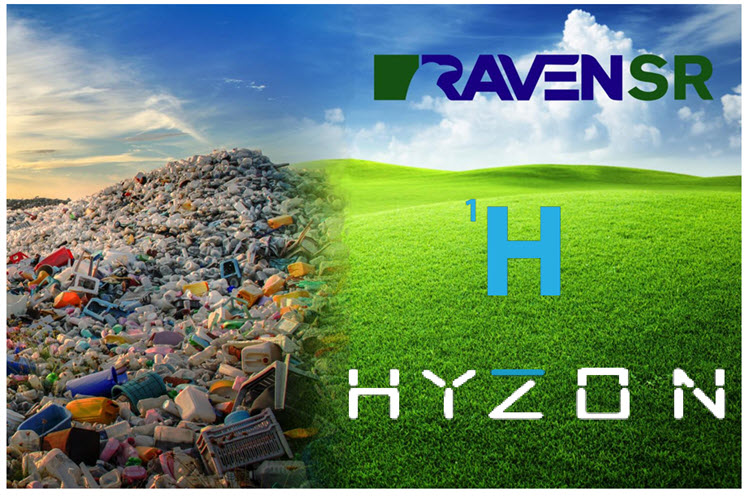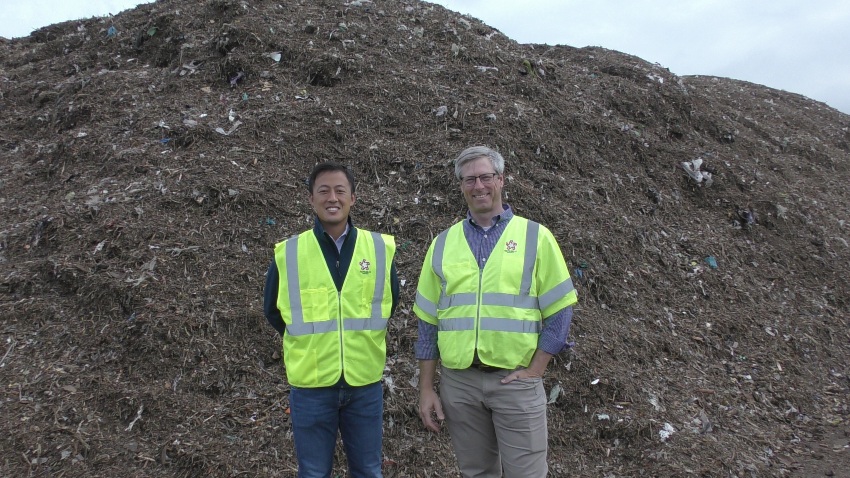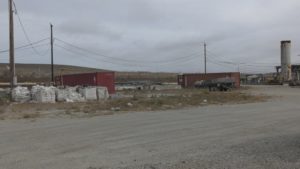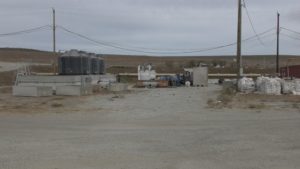
On 10.06.2021 Fuel Cells Works met Raven SR’s CEO Matt Murdock, Shu Shibuya from Itochu, and Rob Sherman from Republic Services in Richmond, California to get a tour of Republic Services’ landfill in Richmond, which will serve as host to Raven SR’s first commercial site for its non-combustion gasification process where it will turn garbage into hydrogen.
The hydrogen will then be distributed to Raven SR’s partners, with the most prominent of those partners being Hyzon. A partner like Hyzon will then use the hydrogen to fuel the FCEVs (fuel cell electric vehicles) buses and trucks that it is producing right now.
Before going out Rob shared two vials, which can be seen in the below photo. The vial on the left is filled with the primary byproduct of Raven SR’s non-combustion process while the vial on the right is filled with the feedstock that Raven SR will be using.

The four of us then got into a truck with Rob in the driver’s seat where he guided us through the facility. The landfill primarily only handles organic waste, like green clippings, these days, and Rob took us to where Republic Services processes that waste. There are three parts to its process. The first pile is where the waste is initially dumped, and then it is then fed into machines that crush it into smaller pieces. The pile in the below photo behind Matt and Shu is the second stage of the process where the waste has already been crushed, and waste in that pile is going to be Raven SR’s future feedstock.

Shibuya (Itochu) – Matt Murdock (Raven SR)
In the final stage Republic Services takes the crushed waste and puts it into rows where microbes break it down into fertilizer. Rob stressed at the beginning of the tour that Republic Services takes care to ensure that the fertilizer reaches a temperature of at least 133 degrees before it can be sold. By subjecting the fertilizer to a temperature of 133 degrees it kills any pathogens that might be lurking, thereby ensuring that the end user obtains a product that is both nutritious (for seeds and plants anyway) as well as free of pathogens that can infect humans and other animals.
We then went to the site at the landfill (picture below) where Raven SR is going to setup shop. Matt explained at the site that the stacks in the below photo are where Republic Services presently has to burn off low methane since it is unable to use it for any industrial process. However, Matt is hoping to also use that methane in its non-combustion process in order to increase its hydrogen production rate.


After the tour, Fuel Cells Works then sat down with Matt and Shu to talk about its future work at the site and hydrogen. Matt also sent to Fuel Cells Works a rendering of what Raven SR’s future Richmond site will look like (see below), though it may change slightly if Raven SR decides to put a roof over its facility. Ultimately, the Raven SR facility will only cover a small part of the land that the landfill encompasses.
FCW: How many kilograms of hydrogen is Raven expecting to produce each day at the Richmond site?
4,500kg, but if we can take the low methane which the site currently flares then production could go up to 5,500kg.
FCW: How is the hydrogen that Raven produces going to get into the trucks that Hyzon is producing? Is there going to be a hydrogen refueling station built at this location? If there is going to be a refueling station on-site, then has an agreement been setup that will the trucks for Republic Services’ to use the refueling station?
So no, not here. There is an option. Hyzon is doing hydrogen garbage trucks and that is a discussion that they are having with lots of different people, and that could be something down the road. And at that point there could be an inside the fence dispensary unit, but that is not being discussed right now. What will probably happen is that Hyzon has a lease agreement. With them as a partner investing in the project, we are actually just sharing the molecule [hydrogen] so a certain amount of the molecule just belongs to them, which they can then include in their lease agreement with whoever their lease agreement is with. So, in the beginning obviously I think their fleet is just going to grow. Their demand right now is going to be less than it will be from say a year from now, so we will sell that on a spot market, sell to local fueling stations. And then that agreement could be extended to Chevron or Shell or somebody else so that if you have a Hyzon truck you can pull into a Shell station and get your hydrogen there.
I think the goal that Hyzon has, though, is that they are probably going to have that back to base model. The U.S. Postal service is an easy example where the truck comes back, reloads, and then does it tour. The closer to base that you can have a fueling station is probably going to be the ideal situation. So, it is just going to depend on where that fleet is located and how many it will be. Down the road I can see us doing a fuel station as their fleets grow bigger or if they have a large enough fleet. I think most people would rather have it outside the fence so that you can make that hydrogen available to everybody. The nice thing about this discussion is that with Hyzon…You know the dilemma that we had in the very beginning is we had 5,000kg who are we going to sell it to? The demand is not that great, but thankfully the demand has increased. By actually creating enough hydrogen and providing it to the fuel stations so that the semi-trucks can use it, now the fueling stations are going to have a ready supply of hydrogen so why wouldn’t I buy a hydrogen car, right? Because now there is hydrogen available. Up until now if I have a hydrogen car how far can I go? Where can I refuel? But as more and more of those hubs get built out it will actually indirectly strengthen the passenger car economy.
FCW: Is Raven going to use products from a company, like GenH2, to liquify the hydrogen that it produces?
Not yet. Liquification is going to require at least 10,000kg to make it economically feasible. So far, we are doing gaseous. We are doing it high pressure for one client, but we are probably going to do it lower pressure, 5,000 bars for another client. But when we get to that stage, that is the big debate in the hydrogen world, liquid or gaseous. You have Shell for example who is very safety conscious who has said [it is likely] never going to liquid. We are probably going to stay gaseous to begin with, and then when we get up to 10,000kg if there is a demand for liquification then we will probably…One of the things that Raven tries to do is that if someone does something well then let’s take advantage of it. That is why we have different partnerships with different organizations. If you do this really, then I don’t have to reinvent the wheel.
FCW: Is carbon black a byproduct of Raven’s Steam/CO2 reforming process? If it is a byproduct, then does Raven have any agreements with other organizations to buy Raven’s carbon black?
We call it bio-carbon. It is essentially bio-char if you will. Dr. Galloway who invented the process was very…this is non-combustion. There is zero carbon combustion. There is no oxygen, it is reductive chemistry. Because of that he [Dr. Galloway] said it is not bio-char, char says it is burning. If there are silicates, if there are chlorides, if there are sulfides, whatever is in that feedstock is going to drop out there. So that by the time that solid gets processed into a gas you are probably looking at methane, carbon monoxide, carbon dioxide, hydrogen, and water going into our second stage reformer, which converts all of that into the hydrogen.
It is going to depend on the quality of the feedstock. Our process is not taking out all of the hydrocarbons from it. We had one guy in the coal industry looking at it saying “gee, I can blow a couple more things out of this thing,” but we have not really explored that too much, yet.
FCW: What company or companies are going to be utilizing the synthetic fuels that Raven is going to produce?
This site is going to be 100% hydrogen to begin with. We are going to do 100% hydrogen in 2022 and then hopefully in 2023 we will be into sustainable aviation fuel.
FCW: How much does it cost to build each Raven site?
We are still coming up with our final numbers, but safely above $20M.
Our goal is to produce hydrogen because the big push for Hyzon or any vehicle is that total cost of ownership. At the end of the day, is this as good or better than the internal combustion, right? So, the answer has got to be yes. Our total cost of ownership…Our goal is to hit once we are up and going and second and third generation we are hoping it can compete very well with SMR. And then at the same time the LCFS definitely helps. We are producing hydrogen at a pretty low price already, which makes it very attractive for a Hyzon company.
FCW: What states is Raven looking to build facilities in once the Richmond and San Jose sites are up and running?
New York, Washington, Oregon, Wyoming, Virginia, Florida. Internationally, Canada, Taiwan, Singapore, Japan, multiple locations in Europe. That is our goal to roll out the first couple of units and really get to that place where everybody knows we can do what we can do, and then probably just do a very large build out in 2023. We purposefully hired a construction firm that can build multiples of these units at one time, because we really want to lay down multiples at once and not do one every six months. We are probably going to start pre-ordering on long-lead equipment in the next six to seven months for major systems.
FCW: How many employees will it take to operate each site and will those employees belong to Raven, Republic Services, or another company?
Raven is going to own and operate all the systems for the first few years. We are not planning on doing any licensing or selling of the equipment, partially because we want to improve the technology more and make sure we have control of the intellectual property. Also, before we can start licensing you are going to have go give guarantees, and we need to have a couple 20,000-30,000 hours of operation before we can give guarantees to people for licensing. I think we are scheduling 3-5 employees. It is intended to run 24×7. We have scheduled downtime every month whether we actually need it each month we will determine. In theory the waste will go into a feedstock management and be automatically fed into our system. It is really not complicated to run it. Moving the bio-carbon out of the way is the hard part.
How does Raven feel about the regulatory environment in California? Have the different levels of government in California been supportive of Raven’s efforts?
Honestly, on a permitting side it has been much easier than I was expecting. I was expecting it to be a nightmare and it has not been. Partially because we are really hitting a really felt need dealing with ways to create clean fuels in a non-combustion manner. Air quality is straight forward because we do not have the combustion. We are a small enough operation in the sense that you run around in 100 tons a day it fits into a calorie cycle. We are actually doing the CEQA permitting for 250 tons here [in Richmond] and 500 at the other location [San Jose], because that is what they are permitted at. We are just going to do the initial permitting up to that. Richmond is permitted up to 250 waste per day for just the waste part, but Raven is only handling 50 tons of that per day right now. If it handled more then it could produce more hydrogen.
What does the future look like for Raven? If we could fast forward to 2031, then would Raven have a number of sites like the Richmond one spread out across the U.S? Does Raven have plans to expand into other segments of the hydrogen sector?
We have really good partnerships. If it comes down the road and it is better for us to run a fueling station, I suppose we could. We have Chevron as a partner. We have enough partnership where I do not think we need to. If down the road we have economies of scale that happen and that makes it better for the client and better for the company we can, but for right now we are comfortable just being the producer.
FCW: Does Raven have any plans for an IPO in the future?
Yes, we do.
Raven SR is also going to build another site in 2022 in San Jose, California. One of the best parts of its hydrogen production method is that it is something that can be scaled, and it is something that can work anywhere there is a landfill. This gives it a an edge in a place like California where there is not a lot of spare fresh water, but it also will enable municipalities to extend the life of landfills that are currently active given that Raven SR turns waste into hydrogen. Perhaps the best part, though, is for places like Hawaii which currently have to import all of the fossil fuels they consume. With Raven SR’s hydrogen production method not only could they then reduce costs by eliminating the importing of fossil fuels, but by reducing the waste that such places create it will then enable for cleaner landscapes. Cleaner landscapes are especially valuable in a place, like Hawaii, where tourism is a significant component of its economy.
In a world filled with fumes from fossil fuel-burning internal combustion engines and waste that clogs rivers and creates artificial islands in the ocean, Raven SR’s system represents a powerful ray of hope not only for responsibly helping to clean up the world but also for transforming the global economy into one based on low carbon intensity hydrogen production and happy fuel cell stacks.



Jesse Lyon, Contributor
The views and opinions expressed herein are those of the authors and do not necessarily reflect the official policy or position of Fuel Cells Works, its directors, partners, staff, contributors, or suppliers. Any content provided by our contributors or authors are of their own opinion and are not intended to malign any religion, ethnic group, club, organization, company, individual or anyone or anything.
Read the most up to date Fuel Cell and Hydrogen Industry news at FuelCellsWorks




